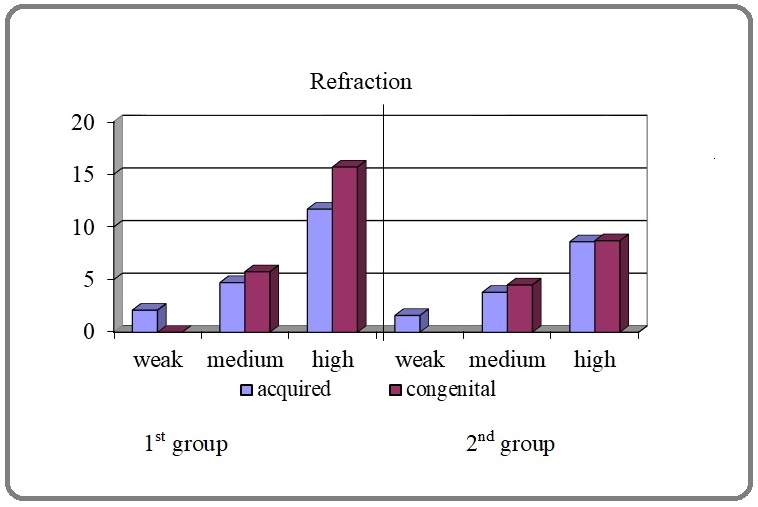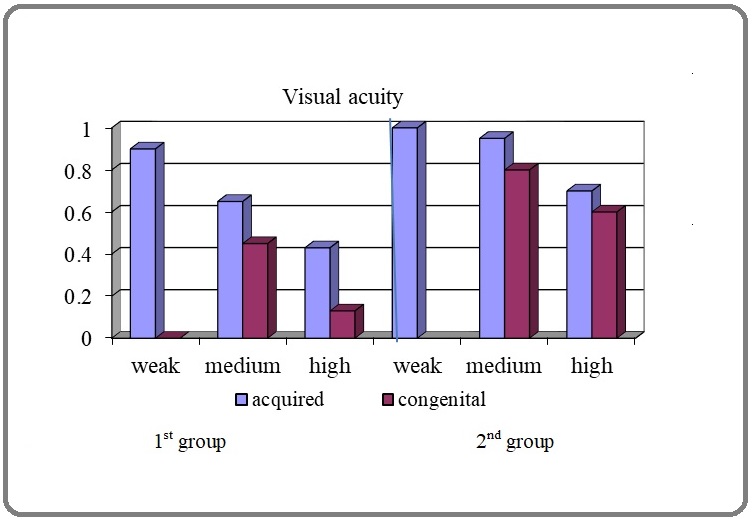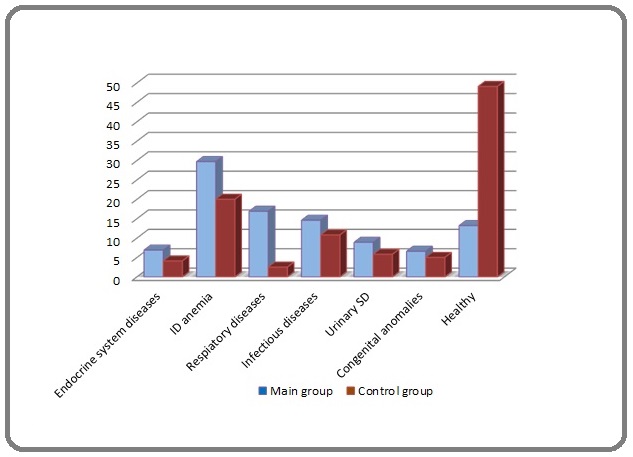Some Features of Clinical and Functional Indicators of Myopia in Children in the Republic of Karakalpakstan
Download
Abstract
The Southern Aral region is characterized by adverse environmental factors that affect human health, including the organ of vision. The comparative estimation of myopia clinical course peculiarities among 333 children aged 2 to 18 years living in the Southern Aral of Karakalpakstan and Samarkand region of Uzbekistan was carried out using the general clinical and ophthalmological methods. In the Southern Aral region, the complicated course of myopia and the proportion of congenital myopia in children was relatively higher than in the control group, which in turn is the cause of the aggravated course of myopia. Further more, extraocular pathology in myopia patients was more frequent among children living in the Southern of the Aral region (over 80%) than in the ecologically favorable area (less than 50%). The obtained data should be considered for drawing up a regional plan for the development and functioning of the children’s ophthalmological service of Karakalpakstan based on elaborating an integrated approach to prevent myopia occurrence and treatment, taking into account residence region and children health.
Introduction
In the structure of the main causes of visual disorders in children and adolescents, at present, there are refractive errors [1-7], and this is confirmed by the fact that refractive disorders are included in the WHO program “Elimination of removable blindness in the world. Vision 2020” [5, 6, 8]. The program notes that childhood blindness due to refractive disorders is considered preventable blindness, therefore, the study of the clinic and the course, as well as the treatment and prevention of complications in children remains one of the urgent problems of pediatric ophthalmology [2, 8-11]. The widespread high prevalence of myopia with a tendency to progression in children, its leading position in the structure of disability among the pathology of the organ of vision is one of the main problems in pediatric ophthalmology [2, 8, 10-11].
According to the conclusion of the UN Commission on the Environment (UNEP), the Aral Sea region is recognized as an ecological disaster zone. This region includes the Republic of Karakalpakstan and the Khorezm region of the Republic of Uzbekistan [13, 14].
The unfavorable environmental situation in the South Aral Sea region affects human health, which is manifested by a high frequency of extraocular pathology, has a negative effect on the occurrence and aggravates the pathology of the organ of vision, including myopia in children and adolescents [3, 15, 16].
Purpose of the study
To study the features of the clinical course of myopia in children living in the southern Aral Sea region.
Materials and Methods
A comprehensive examination of 333 patients with myopia at the age from 2 to 18 years was carried out, of which 213 patients lived in the South Aral Sea region (group I - main) and 120 children - in Samarkand region (group II - control).
General clinical (collection of anamnestic data, results of dispensary examination, as well as analysis of reporting and accounting medical documentation) and ophthalmological research methods (visiometry, perimetry, biomicroscopy, tonometry, refractometry, ophthalmoscopy) were carried out. Clinical refraction of the eye was determined by subjective and objective methods using a spectacle set of test lenses, skiascopic rulers and an autorefractometer from Zeiss (Germany). Reverse and forward ophthalmoscopy was performed using an ophthalmic kit and an EO-II electric hand-held ophthalmoscope (Russia). Echobiometry was performed in A and B modes using an ultrasound diagnostic system model OT1 - Scan 2000 (Canada). The OT1 - Scan program runs on a Windows XP Desktop PC and uses its interface to control the operation of the system. Statistical data processing was carried out using the standard Microsoft Excel application program with the calculation of statistical values.
Results and Discussion
Due to the fact that in most cases myopia was bilateral, and therefore, when describing the results obtained, data on the number of eyes are given. The age composition of the patients was as follows: under the age of 2 years - 30 (8.9% - 59 eyes), from 2-4 years - 44 (13.7% -90 eyes), from 5 to 7 years - 39 (11.4% -77 eyes), at the age from 8 to 14 years old - 80 (23.7% -154 eyes), from 15 to 18 years old - 140 (42.2% -276 eyes). Unilateral myopia was observed in 6 (1.8%) patients in the main group and in 4 (1.2%) patients in the control group of them: a weak degree was diagnosed in 3 cases in group I and in 2 cases in group II, medium degree in 2 cases in group I and in one case in group II, and with a high degree - one eye in both groups. Low myopia in group I was diagnosed in 237 (36.1%) eyes and 150 (22.8%) eyes in group II; moderate myopia in group I was detected in 92 (14.0%) eyes and 55 eyes (8.38%) in group II; high myopia was observed in 91 (13.8%) eyes in group I and 31 (4.72%) eyes in group II. The majority of patients consisted of faces with mild myopia 387 (58.9%) eyes, moderately 147 (22.4%) eyes, high degree 122 (18.6%) eyes. According to the age period of the onset of myopia: moderate congenital myopia was detected in 38 (9.04%) eyes - in group I and in 28 (11.9%) eyes - in group II, a high degree of myopia was diagnosed in group I by 64 (15, 2%) eyes and 22 (9.32%) eyes - in group II.
Acquired myopia of mild degree was detected in group I in 237 (56.5%) eyes and 150 (63.6%) eyes in group II, average degree in group I was diagnosed in 58 (13.8%) eyes and 27 (11, 4%) eyes in group II, a high degree of disease was observed in group I in 23 (5.47%) eyes and in 9 (3.81%) eyes in group II (Table 1).
| Observation groups | Observation areas | Types of myopia | |||||||||
| congenital | acquired | ||||||||||
| Myopia degree | |||||||||||
| medium | high | weak | medium | High | |||||||
| abs | % | abs | % | abs | % | abs | % | abs | % | ||
| Main | Total n=420 | 38 | 9,04 | 64 | 15,2 | 237 | 56,5 | 58 | 13,8 | 23 | 5,47 |
| Control | Total n=236 | 28 | 11,9 | 22 | 9,32 | 150 | 63,6 | 27 | 11,4 | 9 | 3,81 |
With acquired myopia of a weak degree in group II, myopic refraction is 1.3 times weaker, and visual acuity (1.0) is 1.1 times higher than in group I. In patients with moderate myopia in group II, the refractive power is 1.25 times lower, and visual acuity is 1.46 times higher than in group I. With high myopia in group II, the refraction value is 1.3 times less and visual acuity is 1.4 times higher than in group I (Figure 1).
Figure 1. Refractive Indices by Degrees.

In patients with moderate congenital myopia and in patients in group II, visual acuity is 1.7 times higher than among those in group I. In group II patients with high degree of congenital myopia, visual acuity is 4.6 times higher than in group I.
Thus, a direct correlation was found between visual acuity with spectacle correction and the degree of refraction: the higher the degree of myopia, the lower the visual acuity. Patients of group I showed a tendency towards lower visual acuity, as well as higher refractive indices and maximum spectacle correction, compared with patients of group II. In group II patients with low values of myopic refraction, a high visual acuity was noted, which, in stationary forms, was accompanied by a favorable prognosis of the course of myopia (Figure 2).
Figure 2. Indicators of Visual Acuity in the Observation Groups.

A high degree of myopia was recorded both among children in the South Aral Sea region and among children in the Samarkand region, but among children in the South Aral Sea region, it was found significantly more often (P <0.001).
In the 1st group of patients with acquired myopia, astigmatism was observed in 111 eyes (34.9%), i.e. 2.5 times more than in the 2nd group. While in the 2nd group with acquired myopia, astigmatism was observed only in 27 eyes (14.5%), while astigmatism with a difference of up to 2.0 D. was detected in 13 eyes (6.98%), more than 3, 0D. 10 eyes (5.4%) and with a difference of more than 5.0 D. was found in 4 eyes (2.15%) (Table 2).
With congenital myopia in the 1st group, astigmatism was detected in 56 eyes (54.9%), which is 1.8 times more than in the 2nd group. In group 2, astigmatism was observed only in 11 eyes (22.0%), while astigmatism with a difference of up to 2.0 D. was diagnosed in 6 eyes (12.0%), more than 3.0 D. 3 eyes (6.0%) and with a difference of more than 5.0 D. was found in 2 eyes (4.0%) (Table 2).
| Observation groups | Types of myopia | Indicators of refraction, astigmatism and anisometropia | ||||||||||
| Index of refraction, diopters | Magnitude of astigmatism, diopters | value of anisometropia | ||||||||||
| 1,0-3,0 | 3,5-6,0 | 6,5> | Total eye | <2,0 | >3,0 | >5,0 | Total eye | <3,0 | >3,0 | Total eye | ||
| 1 st main group n=420 | acquired n=318 | 237 | 58 | 23 | 318 | 59 | 37 | 15 | 111 | 33 | 13 | 46 |
| 74,5 | 18,2 | 7,2 | 76,0 | 18,5 | 11,6 | 4,7 | 34,9 | 10,3 | 4,0 | 14,4 | ||
| Congenital n=102 | 38 | 64 | 102 | 10 | 31 | 19 | 56 | 9 | 14 | 23 | ||
| 37,5 | 62,7 | 23,9 | 9,8 | 30,4 | 18,6 | 54,9 | 8,8 | 13,7 | 22,5 | |||
| 2 nd control group n=236 | acquired n=186 | 150 | 27 | 9 | 186 | 13 | 10 | 4 | 27 | 9 | 5 | 14 |
| Congenital n=50 | 28 | 22 | 50 | 6 | 3 | 2 | 11 | 4 | 2 | 6 |
It should be noted that astigmatism in congenital myopia in the 1st and 2nd groups occurred 1.5 times more often than with acquired myopia and 2.5 times more was observed in the 1st group.
Anisometropia with acquired myopia in the 1st group of the examined patients was observed 2.0 times more than in the 2nd group.
It should be noted that anisometropia with congenital myopia in the 1st and 2nd groups was 1.6 times more common than with acquired myopia and 2.0 times more was observed in the 1st group (Table 2).
When studying the indicators of the state of the fundus in patients with acquired and congenital myopia, the prevalence of the complicated course of congenital (74%) and acquired (22%) myopia in the ecologically unfavorable region of the southern Aral Sea region (Republic of Karakalpakstan) was revealed than in the control group (Table 3).
| Zones | Types of myopia | Condition of the fundus | ||||
| Groups | Uncomplicated | Complicated | ||||
| abs | % | abs | % | |||
| 1 st main group | Total for the South Aral Sea region n=420 | Acquired n=318 | 248 | 77,9 | 70 | 22,0 |
| Congenital n=102 | 29 | 26,0 | 73 | 74,0 | ||
| Total for the Samarkand n=236 | Acquired n=186 | 159 | 85,4 | 27 | 14,5 | |
| Congenital n=50 | 36 | 72,0 | 14 | 28,0 |
In the structure of extraocular pathology identified among the surveyed contingent, diseases of the blood and hematopoietic organs were most often diagnosed, namely, iron deficiency anemia, which was observed in 63 patients (29.7%) in group I and 24 patients (20%) in group II; in second place in terms of incidence among children were respiratory diseases, which were observed among 36 (16.9%) children in group I and 3 (2.5%) children in group II; the third place in the incidence rate was occupied by infectious diseases, in the structure of which hepatitis prevailed, which was transferred in 31 (14.6%) patients in group I and 13 (10.8%) patients in group II.
The next places were occupied by endocrine diseases, among them hypothyroidism - in group I in 21 (9.9%), and in group II in 5 (4.1%) patients; diseases of the genitourinary system were less common - in 19 (8.9%) patients in group I and 7 (5.8%) patients in group II. Congenital anomalies were observed in 14 (6.6%) patients in group I and 6 (5.0%) patients in group II. While the number of healthy children in group II was 59 (49.1%) children, in the South Aral Sea region in group I without concomitant pathology was found only in 28 (13.2%) children (Figure 3).
Figure 3. The Structure of Extraocular Pathology in the Comparison Groups.

In conclusions, the results of the study of the clinical status show a more aggravated course of myopia in children and adolescents living in the southern Aral Sea region than in the control group. The proportion of congenital myopia in the region of the southern Aral Sea region is more prevalent than in the ecologically favorable region, which is the cause of the aggravated course of myopia in children and adolescents in this region. The presence of extraocular pathology in patients with myopia is significantly more common in the southern Aral Sea region (over 80%), while in an ecologically favorable region it does not exceed 50%. Thus, the data obtained must be taken into account when drawing up a regional plan for the development and functioning of the children’s ophthalmological service of the Republic of Karakalpakstan based on the development of an integrated approach to the prevention and treatment of myopia, taking into account the region of residence and the state of health of children.
References
- The influence of some external and internal factors on the course of acquired myopia in children Eremenko K.Yu, Fedorishcheva L.E, Alexandrova N.N. Russian Ophthalmological Journal.2011;4(1):27-31. (in Russian).
- Acquired myopia: integration of risk factors for development and progression Ivanova N.V, Kondratyuk G.I. Tauride medical and biological bulletin.2013;16(3):63. (in Russian).
- Identification and analysis of the incidence of eye pathology in the population of Navoi, Samarkand regions and the Republic of Karakalpakstan Sidikov Z.U, Ashirmatova Kh.S, Fazylova Z.A. Actual problems of eye microsurgery: Mater. scientific-practical conf. - Tashkent.2011;:29-30. (In Russian).
- Assessment of the incidence of eye diseases in the population of the Republic of Uzbekistan from the standpoint of the need for ophthalmic surgical care Sidikov Z. U. East-West.2015;(1):28-30. (In Russian).
- Myopia: more than just an inconvenience. // Mater. 9th International scientific-practical. conf. on contact correction. - Moscow, 2015. - From 8-9. (in Russian) Xu Cheng. .
- Myopia: incidence, pathogenesis, management, and new possibilities of treatment. Russian DamianCz . Ophthalmological journal.2014;1:96-101.
- Global Prevalence of Myopia and High Myopia and Temporal Trends from 2000 through 2050 Holden Brien A., Fricke Timothy R., Wilson David A., Jong Monica, Naidoo Kovin S., Sankaridurg Padmaja, Wong Tien Y., Naduvilath Thomas J., Resnikoff Serge. Ophthalmology.2016;123(5). CrossRef
- Elimination of Avoidable Blindness: WHO World Initiative Libman E.S, Shakhova E.V. Mater. Grew up. interregion. symp.2003;:38-43. (In Russian).
- The problem of school myopia // Journal of the Bulletin of the Orenburg State University Kireeva N.V, Zharov V.V, Golikova E.V. 14.2011;133:136-142. (In Russian).
- The prevalence of myopia in schoolchildren of some regions of Russia Proskurina O.V, Efimova M.N, Markova E.Yu, Khvatova N.V, Brzheskiy V.V, Slyshalova N.N, Efimova E.L., Egorova A.V. Ophthalmology.2018;15(3):348-353. (In Russian).
- Medical and social aspects of myopia prevention among schoolchildren enrolled in innovative programs: Author's abstract. diss ... cand. med Shiller S.I. sciences. - Moscow, 2012 .-- 42 p. (In Russian)..
- Modern aspects of the incidence and course of myopia Lantukh V.V, Kim T.Yu, Utyupina K.Yu, Koltochikhina I.V, Zelinskaya O.A. Medicine and education in Siberia.2014;(3):S. 57-63. (In Russian).
- Aral Sea Crisis and Medical and Social Problems of Karakalpakstan. - Nukus, 2001 Ataniyazova O.A, Konstantinova L.G, Eshchanov T.B. ;:P.116. (in Russian).
- Ecological and medico-demographic problems of the Aral Sea region and the state of health of the child population in this region Baranov A.A, Ignatieva R.K, Kagramanov V.I. Pediatrics.1993;5:S. 76-79. (in Russian).
- Features of the clinic and the course of myopia among the population living in the region of the southern Aral Sea region: Author's abstract Kurbanazarov M. diss ... cand. med. sciences. - Tashkent, 2019 .-- 52 p. (In Russian)..
- The role of extraocular pathology in the pathogenesis of myopia in children and its complex treatment: Author's abstract. diss ... cand. med Chetyz RR. sciences. - Moscow, 2007 .-- 25 p. (In Russian)..
Author Details
How to Cite
- Abstract viewed - 0 times
- PDF (FULL TEXT) downloaded - 0 times
- XML downloaded - 0 times